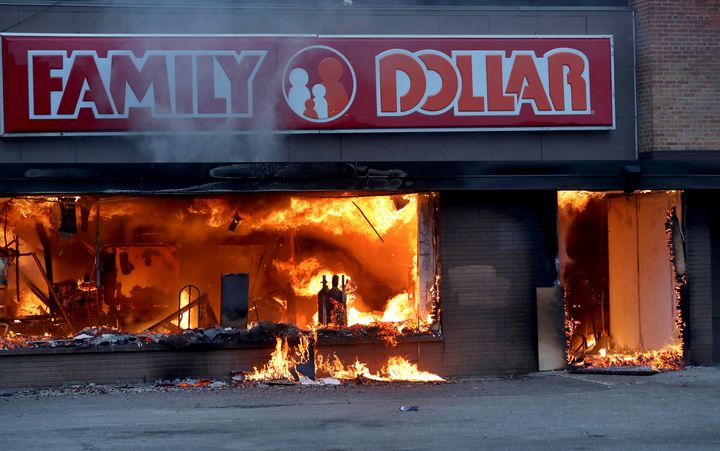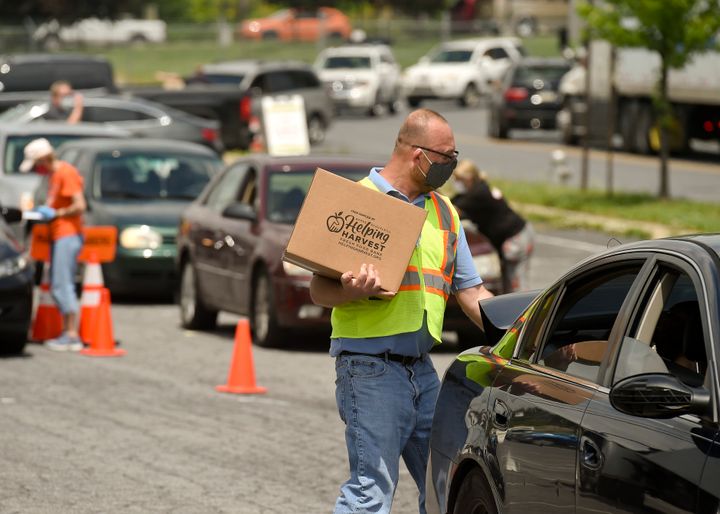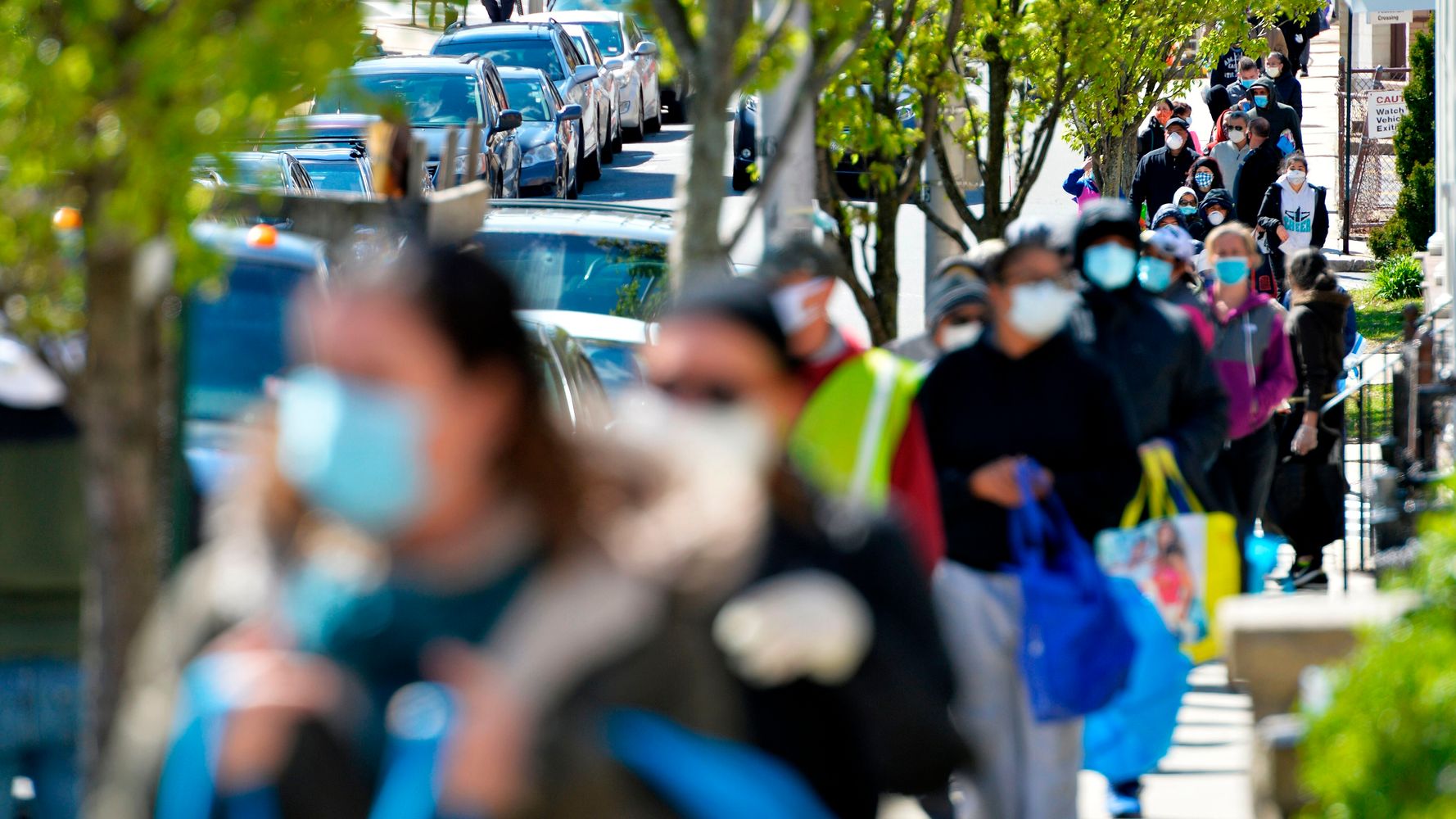[ad_1]
As unemployment rates increased due to the coronavirus pandemic, so too did the number of people relying on food pantries to survive. Over the past week, the destruction of property and the fear of violence (by police and others) accompanying a nationwide wave of racial justice protests has just made the situation more difficult.
HuffPost spoke to senior staff at charitable organizations to learn whether food-insecure people in their cities are now even more at risk.
Dedication Prevails Over Disruption
Looking at the destruction of property along Lake Street in South Minneapolis, TC Food Justice executive director Autumn Chmielewski concluded that safety is paramount.
“I cannot, in good conscience ― given everything that I’ve seen that’s happening, personally, as I’ve watched buildings burn to the ground in my neighborhood and people’s protests turn into riots ― I can’t have volunteers out in that situation,” she told HuffPost.
TC Food Justice rescues fruits, vegetables and other food that co-ops, grocery stores and farmers markets have deemed unsalable and brings it to local hunger relief organizations. For now, Chmielewski said, it’s up to her nonprofit’s small staff — all volunteers themselves — to handle that redistribution in addition to administration.
“COVID really started to shine a light on the inequities of society. When you are looking at the health disparities and who lost their jobs and who had to continue working in dangerous situations, there’s no justice in that. And the food system is no different.”
– Autumn Chmielewski, executive director of TC Food Justice
The challenge is to continue sourcing food and getting it to those in need. Not far from where TC Food Justice rents its cooler space, three of the four local supermarkets were damaged by fire last week.
“There’s all of a sudden less food everywhere,” Chmielewski said. “Places established as safe spaces to get food, to get help, to get assistance, are no longer safe and, in some cases, are no longer there.” She added, “At least one of our food pantry partners was damaged because it was on Lake Street and they had to shut down.”
In response, TC Food Justice is partnering with Urban Ventures, Sisters Camelot, the Salvation Army and St. Vincent de Paul, among others, to mobilize a reliable food source for local residents. They plan to have fresh and dried food available for pick up at designated neighborhood sites and will also offer home delivery by bicycle. “We’re hoping that within a week, we’ll be ready to go,” Chmielewski said.

Richard Ayoub, executive director of Project Angel Food in Los Angeles, can certainly relate.
“[Monday] we were spared ― there was no damage to our building,” he said, referring to the recent looting at nearby stores in Hollywood, where the organization’s offices are located. “But still, if you’re inside that building and you don’t feel safe, it’s just not good for our staff to have to deal with that on top of everything else going on.”
Project Angel Food provides medically tailored meals to people living with critical illnesses. According to Ayoub, 76% of its clientele are people of color, 98% are living at or below the poverty line, and many are over the age of 60 and vulnerable to the coronavirus.
Although he sent his staff home early two days in a row, the charity’s drivers were still able to deliver food to clients without incident. “[They] said that police, National Guard and residents are making way for Project Angel Food because they know we’re delivering food,” Ayoub said. “And it’s just powerful and incredible.”
It’s Not Just About Food
Chmielewski relates the events of the past week to her organization’s mission.
“The issue of food is much deeper than just having something to eat — it is a justice issue,” she said. “I think everything that happened with COVID really started to shine a light on the inequities of society. When you are looking at the health disparities and who lost their jobs and who had to continue working in dangerous situations, there’s no justice in that. And the food system is no different, but people haven’t realized that.”
While operations out of Bread for the City’s center in Northwest Washington have been largely unaffected by the protests around the White House, CEO George Jones said recent events have certainly shaken the staff’s morale.

“For at least a decade, we’ve been intentionally trying to deal with the intersection between racism and all the disadvantages — food insecurity, the housing crisis, high unemployment rates, the income disparity — all of those things have long for us been symptomatic of the larger systemic oppressions. That’s always been our reality, our sensibility,” Jones told HuffPost.
Add racist law enforcement to that burden. “It’s just really painful to have these fatal incarnations of oppression,” Jones said. “That’s what these deaths Black people experience at the hands of police or vigilantes are — the worst kind of reminder of what these systems can produce.”
“These are people who believe in the possibility of a just world. And it’s hard … when you get these deadly reminders of how much further we have to go.”
– George Jones, CEO of Bread for the City
It all takes a spiritual and emotional toll on him and his staff. “You know, these are people who believe in the possibility of a just world. And it’s hard when you’ve dedicated your life — I’ve been at Bread almost 25 years — it’s hard when you get these deadly reminders of how much further we have to go,” Jones said.
How You Can Help
Food shelters across the country are seeing greater demand under these challenging circumstances. Over the past couple of months, Bread for the City went from serving up to 400 families in a day to as many as 800 families. Project Angel Food added 400 new clients to its program just in the month of May.
Kyle Waide, president and CEO of Atlanta Community Food Bank, estimates a 40% increase in clients since the pandemic began. “That means that we’re trying to serve 300,000 to 400,000 more people,” he explained, which requires finding new sources and buying more food. Adding to the cost and complexity of how they’re operating is the need to curb the coronavirus by modifying the way they distribute food to limit person-to-person contact and increasing cleaning and sanitation practices.
“We’re now distributing 2 million pounds of food a week,” Waide said. “That’s a 35% increase over what we were doing before, and we expect that that’s going to continue indefinitely.”
Yet another thing that all of these organizations have in common is that they depend on donations and the work of volunteers to survive.
To learn more about food insecurity in the United States and how you can contribute to those in need, HuffPost has put together a list of resources:
-
The Food Waste Reduction Alliance identifies projects for reducing and recycling food waste and donating food to those in need.
-
The Food Recovery Network enables students at colleges and universities across the nation to fight food insecurity and reduce food waste.
-
Feeding America is a hunger relief organization with resources to help you take action or locate a food bank near you.
-
FoodPantries.org is an online directory of food pantries, soup kitchens and other nonprofits dedicated to fighting hunger.
-
The Salvation Army runs food pantries, meal programs and community gardens as part of its fight against food insecurity.
-
The Homeless Shelter Directory lists emergency food resources by state, including food pantries, food banks and soup kitchens.
-
Food Rescue US partners with businesses and agencies in cities across the country to provide free meals to those in need.
-
The U.S. Department of Agriculture’s Economic Research Service publishes data on food security, food and nutrition assistance and the Supplemental Nutrition Assistance Program (SNAP).
-
The Healthy People 2020 website, managed by the U.S. Department of Health and Human Services, provides information about food insecurity and economic stability.
[ad_2]
Source link

